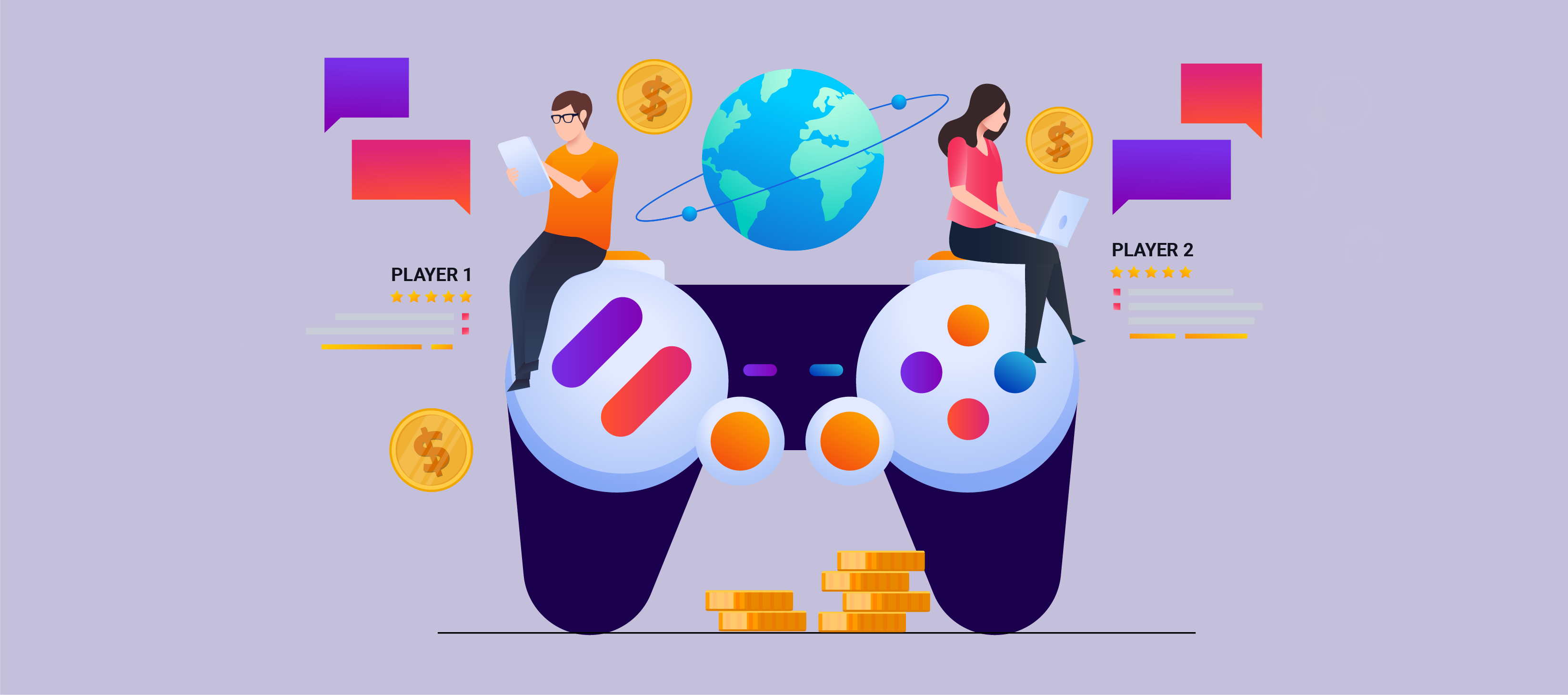Did you realize that the great majority of money invested in mobile app stores is on games? Statista projects that by 2027, there will be 182.0 million active users of mobile game apps worldwide, accounting for 52.9% of all users. It should come as no surprise that mobile games generate the majority of advertising revenue.
Developing a game for mobile devices can cost hundreds of thousands of dollars, particularly for major mobile games like Clash of Clans, with a development range of 8 to 12 months.
For example, the most frequent question that comes to mind while developing a video game app for your company is: “How much does Game Development Cost in India?” Well, Game Development Cost in India can range anywhere from $25,000 to $100,000 or more on average. This guide will provide you with in-depth knowledge of the variables that have the most effects on game development cost estimation, overall game development costs, and the most effective strategy to lower gaming development expenses.
Estimating Game Development Cost in India Depending on the Type of Game
|
Game development type |
Explanation |
Game development cost estimation |
Examples |
|
2D games |
2D games are developed using two-dimensional graphics. They are typically less expensive to develop than 3D games, but can still be complex and time-consuming to produce. |
$20K to $40K | Flappy Bird, Angry Birds, Mario Kart |
|
3D games |
3D games are developed using three-dimensional graphics. They are typically more expensive to develop than 2D games, due to the complexity of creating and rendering 3D graphics. |
$50,000 to $500,000 | Grand Theft Auto V, The Witcher 3, Call of Duty: Modern Warfare |
|
Mobile games |
Mobile games are developed for smartphones and tablets. They can be either 2D or 3D, and can range in complexity from simple arcade games to complex MMORPGs. |
$50,000 – $1 million | Candy Crush Saga, Pokémon GO, Clash of Clans |
|
PC games |
PC games are developed for desktop and laptop computers. They can be either 2D or 3D, and can range in complexity from simple puzzle games to complex first-person shooters. |
$50,000 to $500,000 | World of Warcraft, League of Legends, Civilization VI |
|
Console games |
Console games are developed for video game consoles such as the PlayStation 5 and Xbox Series X. They are typically the most expensive to develop, due to the powerful hardware and complex development kits required. |
$50,000 to $500,000 | God of War, The Legend of Zelda: Breath of the Wild, Spider-Man: Miles Morale |
|
Web games |
Web games are developed to be played in a web browser. They can be either 2D or 3D, and can range in complexity from simple casual games to complex MMORPGs. |
$10,000 to $1,000,000 | Angry Birds, Candy Crush Saga |
|
VR games |
VR games are developed for virtual reality headsets such as the Oculus Rift and HTC Vive. They are typically more expensive to develop than traditional games, due to the need to create immersive 3D environments and to develop new gameplay mechanics that take advantage of VR technology. |
$20,000 to $50,000 | Beat Saber, Half-Life: Alyx, Resident Evil 7: Biohazard |
|
AR games |
AR games are developed for augmented reality devices such as smartphones and tablets. They overlay digital elements onto the real world, creating an immersive and interactive experience. AR game development cost in India are typically less expensive to develop than VR games, but can still be complex and time-consuming to produce. |
$10,000 to $50,000 | Pokémon GO, Ingress, Jurassic World Alive |
|
Indie games |
Indie games are developed by small teams or individuals with limited resources. Indie games can be of any genre and can range in complexity from simple casual games to complex RPGs. |
$10,000 to $100,000 | Minecraft, Undertale, Celeste, Hollow Knight |
|
AAA games |
AAA games are developed by large studios with high budgets. AAA games are typically the most expensive to develop, due to the use of high-end graphics and technologies, the need to hire a large team of experienced developers, and the extensive marketing campaigns that are typically associated with AAA games. |
$300,000 to $500,00 | God of War (2018), Elden Ring |
Factors Affecting the Game Development Cost

Here are ten factors that affect game development cost:
1. Game genre and scope
The genre and scope of the game are two of the most important factors that affect Game Development Cost in India. More complex genres, such as action games, tend to be more expensive to develop than simpler genres, such as puzzle games and casual games. This is because more complex genres typically require more features, content, and assets. Additionally, the scope of the game, in terms of its size, ambition and language for game development, will also have a significant impact on cost.
2. Game platform
The platform on which the game is being developed also plays a role in determining cost. Developing games for consoles and high-end PCs is typically more expensive than developing games for mobile devices or web browsers. This is because console and PC games typically require more powerful hardware and more complex development processes. Additionally, some platforms have specific requirements that can add to the development cost.
3. Art style and graphics
The art style and graphics of the game can also have a significant impact on cost. More realistic and complex art styles and graphics will be more expensive to produce. This is because they require more talented artists and more powerful hardware. Additionally, the use of advanced rendering techniques and effects will also add to the cost. For example, developing a game with realistic 3D graphics will be more expensive than developing a game with simple 2D graphics.
4. Game engine
The game engine used to develop the game can also affect the game development cost in India. Some game engines, such as Unreal Engine and Unity, are licensed on a subscription basis, while others are free to use. However, even free game engines can have indirect costs associated with them, such as the cost of training developers to use the engine and the cost of fixing bugs in the engine. Additionally, some game engines are better suited for certain genres and platforms than others. For example, Unreal Engine is a good choice for developing high-end 3D games, while Unity is a good choice for developing mobile games and 2D games.
5. Development team size and experience
Larger teams with more experienced developers will typically charge more per hour than smaller teams with less experienced developers. This is because larger teams have more resources and can be more efficient. Additionally, teams with specialized skills in certain areas, such as art, animation, and programming, will also be more expensive. For example, hiring a team of experienced AAA game developers will be more expensive than hiring a team of inexperienced indie game developers.
6. Development time
The development time of the game is another important factor that affects game development cost in India. More complex games with larger scopes will typically take longer to develop and, therefore, will be more expensive. Additionally, any changes or delays to the development schedule can also add to the cost. For example, if the game’s scope changes significantly during development, the cost will likely increase.
7. Quality assurance
Quality assurance (QA) is the process of testing the game to ensure that it is free of bugs and meets all quality standards. QA can be a significant cost, especially for large and complex games. This is because QA requires a lot of time and resources. Additionally, QA teams need to be familiar with the specific platform and game engine that the game is being developed for.
8. Localization
Localizing the game for multiple languages and regions can also affect the game development cost in India. This is because localization requires the translation of all text and audio in the game, as well as the adaptation of the game to different cultural norms. Additionally, localization projects can be complex and time-consuming, especially for games with a lot of text and dialogue.
9. Marketing and distribution
The cost of marketing and distributing the game is also something to consider. This can include the cost of advertising, public relations, and creating physical copies of the game. Marketing and distribution costs can vary widely depending on the size and scope of the game. For example, marketing a large AAA game will be more expensive than marketing a small indie game.
10. Intellectual property
If the game is based on an existing intellectual property (IP), such as a book, movie, or TV show, then the developer will need to pay licensing fees to the IP holder. This can add a significant cost to the development budget. The cost of IP licensing fees can vary depending on the popularity of the IP and the terms of the licensing agreement.
Pre and Post-Launch Marketing Strategies

Pre-Launch Marketing Strategies
Pre-launch marketing is crucial for generating awareness and excitement for your game before it releases. By starting your marketing efforts early, you can build a community of potential players who are eager to learn more about your game and play it when it launches.
Here are some effective pre-launch marketing strategies:
- Create a strong online presence: This includes building a website and social media accounts for your game. Make sure your website is well-designed and informative and that your social media accounts are active and engaging. Share regular updates on development progress, screenshots, videos, and other behind-the-scenes content.
- Run a teaser campaign: Release short trailers and teasers to generate hype for your game. These teasers should give players a glimpse of the game’s world, characters, and gameplay, but without giving too much away.
- Partner with influencers: Reach out to gaming influencers and see if they would be interested in playing and promoting your game. Gaming influencers have large and engaged audiences, so partnering with them can be a great way to get your game in front of a lot of potential players.
- Run contests and giveaways: Give away beta keys, gift cards, or other prizes to generate excitement and engagement. You can run contests on your website and social media accounts or partner with other gaming websites and influencers to run joint contests.
Post-Launch Marketing Strategies
Once your game has launched, it’s important to maintain momentum with post-launch marketing. By continuing to market your game after it launches, you can attract new players and keep existing players coming back for more.
Here are some effective post-launch marketing strategies:
- Continue to update your game: Release regular patches and updates to fix bugs, add new content, and improve the overall experience for players. This will show players that you are committed to your game and that you are listening to their feedback.
- Run community events: Host tournaments, livestreams, and other events to keep players engaged and coming back for more. Community events are a great way to build relationships with your players and to show them that you appreciate their support.
- Offer discounts and promotions: Run sales and give away promotional items to attract new players and keep existing players coming back. You can also offer in-game discounts and rewards to players who have been playing your game for a long time.
- Continue to build your online presence: Continue to share updates and engage with players on social media. You can also use social media to run contests and giveaways and to promote your community events.
Conclusion
Before you begin development, you must take into account all of the factors of game development cost in India outlined in the article. Because video games are products, they need to be carefully considered when it comes to investment and budgeting. Hiring experienced mobile game development companies like us and outsourcing your project is your best option. We are able to evaluate every variable and offer you a comprehensive quote that includes all of the elements mentioned above, as well as those unique to your project.
FAQs
Question 1: How can I control the expense of developing mobile games?
Careful planning and budgeting are necessary to keep the expense of developing mobile games under control. To make sure your game is in accordance with consumer demand, start by performing in-depth market research and target audience analysis.
Question What fundamental variables influence the price of developing mobile games?
These include the level of complexity and breadth of the game, the choice of platform (iOS or Android), the requirements for graphics and animation, the functionality and mechanics of the game, and the incorporation of third-party APIs.
Question 3: What is the most effective marketing plan for mobile games?
To optimize the success of app stores, a successful mobile game marketing strategy combines both organic and paid components. To guarantee excellent outcomes, this is accomplished by creating a thorough App Store Optimisation (ASO) plan and using paid strategies like Apple Search Ads.
Question 4: What distinguishes app marketing for games from other types of app marketing?
Creative visual components like logos, screenshots, and app preview videos can do a lot for you when it comes to mobile game marketing and help make your game look amazing on app store pages.




